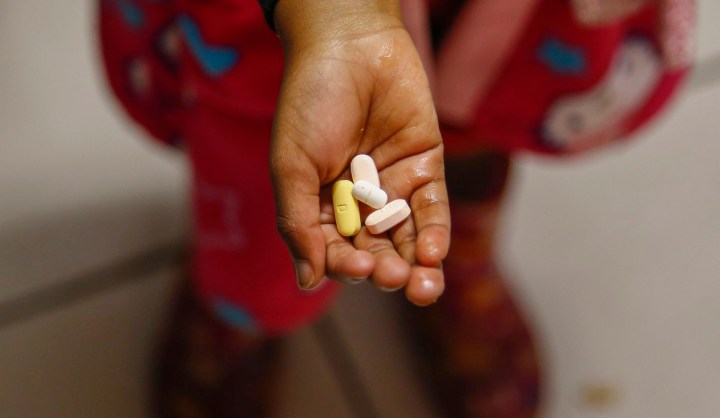SPOTLIGHT
A better pill to swallow – how digital adherence technologies help with adherence to HIV medicines

About 7.8 million people were living with HIV in South Africa in 2022, of whom 5.7 million were taking antiretroviral treatment. Currently, HIV treatment is lifelong, which makes treatment adherence challenging for some. Tiyese Jeranji explores what role digital adherence technologies can play in helping people stay on treatment.
People living with HIV who take antiretroviral treatment typically have a normal life expectancy, provided they keep taking the treatment, but for some taking an antiretroviral pill or pills every day is difficult.
One study from the Western Cape indicates that there are many reasons that patients may not take their medication as prescribed. These include forgetfulness, denial, pill fatigue, poor insight, depression, alcohol use, possible medication side-effects, difficulty with the medication regimen, and concerns about stigma or disclosure.
Then there are also various systemic challenges such as medicine stockouts at facilities and long queues and negative staff attitudes at public-sector clinics, as described in several reports from community monitoring group Ritshidze.
First few months are key
According to Dr Catherine Orrell, clinical lead for the Desmond Tutu HIV Foundation Centre for Adherence and Therapeutics, lost-to-care often happens between the first and the fourth month of starting treatment. That is why it is important to retain people in care in the early months, she says. This means there should be a closer focus on people in these early months to support them, teach them the importance of ART (antiretroviral therapy) adherence, and create good tablet-taking habits.
“The more people on ART, the more challenging it becomes to support everyone within our public health system. For each person there are different issues that lead to non-adherence, but we have limited support options,” she says.
One potential way to help with treatment adherence is the use of digital adherence technologies (DATs).
What are DATs?
According to Dr Christi Jackson, senior technical medical adviser for HIV at the NGO Right to Care, digital adherence technologies are tools that help monitor and improve adherence to medication, such as ART for HIV or TB treatment. These technologies, she says, use various methods to track medication use and provide feedback to patients and healthcare providers.
The #ASCENT project in SA supported by @YHA_Africa research interns observed #WorldTBDay at South Rand Hospital in JHB by conducting #TB services, screening & awareness, including Digital Adherence Technologies (DATs) to support adherence to TB treatment information. #TBMonth pic.twitter.com/tZ1uJlc4ow
— The Aurum Institute (@Auruminstitute) March 30, 2022
Some examples include smart pill bottles or pill boxes designed by Wise-pill, a Cape Town-based company. These devices have electronic sensors that record when they are opened and closed and log this data for the healthcare provider to review. They can also provide an audible reminder when medication needs to be taken, says Jackson. There are also apps to set medication reminders, track medication use and provide education and support for patients. Another example is video-supported treatment where the patient uses a secure app on their phone to record a video of them swallowing their medication and then sharing it with their healthcare provider.
Ultimately, the success of DATs in improving adherence will depend on a range of factors, including patient motivation, access to healthcare and social support.
To date, interventions such as these have more commonly been used for TB treatment than for HIV.
Jackson says DATs can help patients take their medication as prescribed by providing real-time feedback and reminders, which may improve adherence rates. “Additionally, some DATs can send alerts to healthcare providers if a patient misses a dose, allowing for timely intervention,” she says. “DATs can help patients become more aware of their medication-taking behaviour and [can help] identify patterns of non-adherence.”
Patients and healthcare workers also have increasing experience with these new technologies.
“The box has been highly utilised in big trials and was used to support more than 15,000 TB patients in five countries over two years in the ASCENT project,” says Nontobeko Ndlovu, head of research projects at the Aurum Institute. “It’s been seen to be effective and acceptable among patients and healthcare providers.”
A South African study reported at this year’s Conference for Retroviruses and Opportunistic Infections (CROI) found that such adherence monitors improved adherence to TB treatment but did not have much impact on clinical outcomes. “The effect on adherence is important and warrants continued use and evaluation of these technologies,” the authors wrote. “Adaptation of these technologies to cater for those on both TB and HIV treatment is required.”
More promising developments
Orrell also notes some promising new developments in the form of smart pills. These contain a sensor that can detect when the pill is ingested and sends a signal to an app or wearable device. “This one is much harder to cheat. You will have to actually drink your pill for it to register that you have taken it. It could be a real game-changer and help in monitoring adherence,” she says. A study reported at CROI illustrates that such pill monitors can be used successfully to track adherence.
Read more in Daily Maverick: Good news for patients as HIV medicine prices drop dramatically
Another promising step in improving adherence in groups who struggle with taking tablets would be the long-acting injectable ART, Orrell says. “For those who cannot manage tablets, this would work much better. The patient’s only burden here will be to find time to come to the clinic for the injection, but I think it will be much better for some patients than having to take a daily pill,” she says.
‘No single solution’
Despite the potential benefits of DATs, Jackson says it is important to note that adherence is a complex issue and there is no single solution that works for everyone.
“It is also important to consider the potential challenges associated with using DATs such as cost, technical issues and privacy concerns. Ultimately, the success of DATs in improving adherence will depend on a range of factors, including patient motivation, access to healthcare and social support,” she says.
Orrell shares this sentiment and points out that DATs will only be used by people who agree to use them.
Given the number of people living with HIV, to effectively use DATs there must be a specific niche that is catered for.
“With DATs, the challenge is that these devices tend to overestimate adherence. One can open the box, take the pill out, but not take the pill, or pocket a few doses for the weekend. The fact that the pillbox was opened suggests that the pill was taken, though rarely this may not be the case. There is no exact way to monitor adherence,” she says.
Part of the challenge is that a huge number of patients are living with HIV and the treatment is lifelong. “Yes, the boxes can be recycled, but they are expensive and most people on ART find their own ways to adhere to treatment. We need to identify those who need extra help,” Orrell says.
Leading up to #WorldTBDay, #ASCENT published our experiences with Digital Adherence Technology in 5 different contexts. #YesWeCanEndTB & we believe DATs can help achieve better treatment outcomes! https://t.co/PF6pVOv1Rp @UNITAID @KNCVTBPlus @Auruminstitute @LSHTM @PATHtweets
— ASCENT digital adherence (@digitaladh) March 24, 2023
The public health system at the moment is a one-size-fits-all, Orrell says. “It’s either you fit or you don’t. So, some might miss their treatment and the system will not pick this up until weeks or months later. As health workers, we need to notice when our patients are missing or struggling and use what we have available to support adherence. The system could also change to accommodate more people, for example, with evening or weekend clinics or dispensing more ART to stable patients to decongest the clinics and allow more time to focus on those in need.”
But according to Ndlovu, the weakness of the current adherence measures in the standard of care is that non-adherence is only identified at scheduled visits and this is often too late. “The DATs are a game-changer as they reflect non-adherence in real time and intervention is done early,” she argues.
Implementation challenges
There are added implementation challenges, including limited access to technology or smartphones and other devices that are used for some types of DAT. In some areas there are network challenges where cellphone and data networks are poor in some rural areas. “So, things like video calls may be difficult or impossible and messages that must be sent from a device using mobile data networks may be delayed,” says Jackson. “There is limited health infrastructure and South Africa already has a shortage of healthcare providers, especially in rural areas and they will require additional training to implement DATs, which may be challenging. Cost to patients and the health systems have to be considered.”
Treatment for drug-resistant TB can involve long hospital stays and missing work. But digital adherence technologies (DATs) – like smart pill boxes and video-supported treatment – can help people more-easily stay connected to treatment. #WorldTBDay https://t.co/MGaIJmnFtI pic.twitter.com/MhXARHYwED
— The Global Fund (@GlobalFund) March 24, 2023
According to Ndlovu, rolling blackouts have also been a major challenge, leading to more delayed web-based system updates and healthcare workers seeing missed doses even though the patient will have taken the dose.
“Participants still receive reminders for doses already taken due to system errors caused by network disturbances. More cellphones are on voicemail as network connection becomes poor during power cuts and patients are unable to charge their phones, which affects differentiated care,” she says, adding that manual dose entries get done only when patients are reached or when the network is revived and downloads dosage histories.
Only for some groups?
With all that in mind, Orrell says with HIV treatment a lot comes into play since the treatment is lifelong, unlike with TB treatment. She says that given the number of people living with HIV, to effectively use DATs there must be a specific niche that is catered for.
“I think the challenge is actually finding that niche and using DATs to best effect there. Do you use them in pregnant women so that we monitor their adherence during pregnancy to improve adherence to treatment and so they have healthy babies? Do we give it to new moms as we know that adherence is difficult while managing a newborn? Do we give them to adolescents because we know this group really struggles to take daily tablets?” DM/MC
This article was published by Spotlight – health journalism in the public interest.




















Comments - Please login in order to comment.